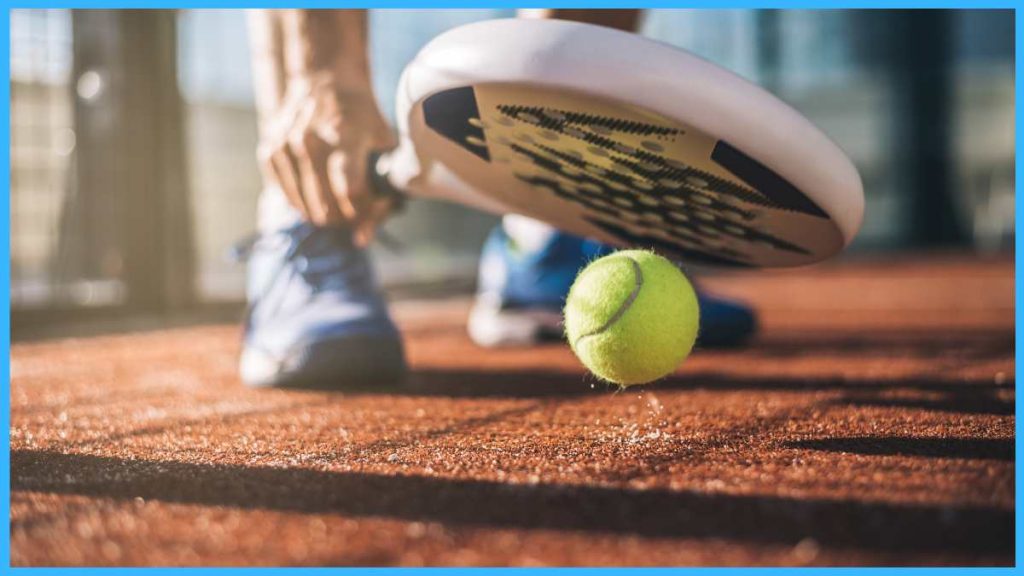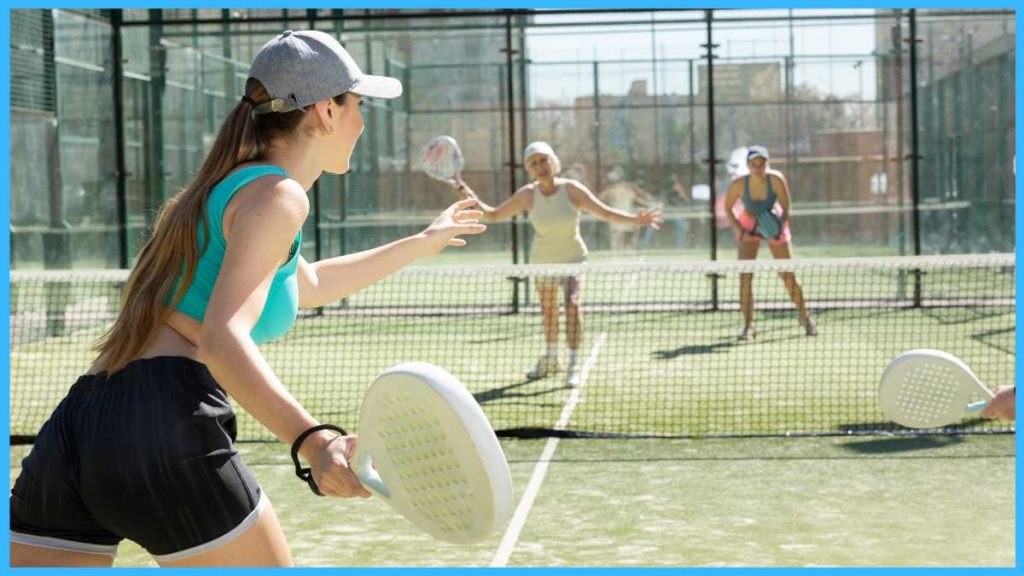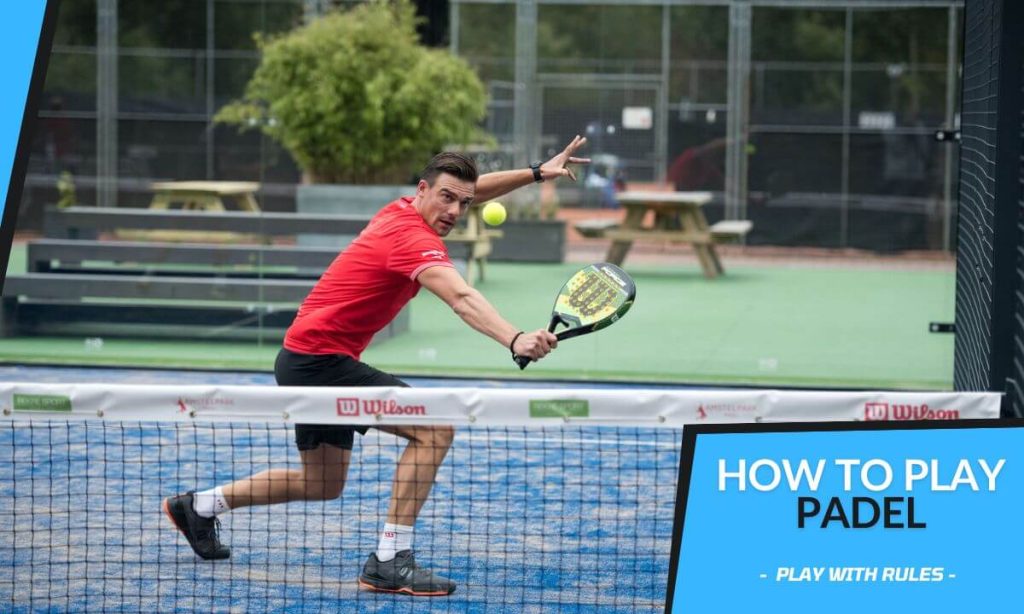Padel Tennis Rules: Padel, a game that craftily blends tennis and squash, has been getting its due recognition of late as a dynamic game. The game combines skill, stamina, and so much more. However, how to play Padel is the most asked question. That’s because the game is played on a smaller court than games like tennis. Padel makes up for it with its strategic and high-octane gameplay.
While the common idea is that anyone who can play tennis and squash would play this game, there are some key differences between Padel and the other racquet games. Let’s find out what the differences are and how to ‘Play Padel With Rules.’
Table of Contents
How To Play Padel?
Using a solid paddle, two teams of two players each rally a ball similar to that used in tennis (with different air pressure). The intention is to outsmart and outsource the opponents’ shots while playing Paddle within the rules. The gameplay is quite similar to both tennis and squash. However, in Padel, players can use the walls to score points, but there are specific protocols for that as well.
Objective
The objective is to win two out of three sets (the first team to win 2 sets wins the game) before your opponent. Since there are walls, the game can get a little tricky, which is why it is important to communicate and coordinate effectively. Each team should aim to work together to score the maximum points and maintain the lead for two consecutive games.

Padel Rules/ Padel Tennis Rules
At the core of it, Padel is essentially the same game as that of tennis (in nature). However, there are a few critical differences that make Padel a really fast-paced and exciting game. Let’s proceed step-by-step and learn how to play Padel like a pro.
General Padel Tennis Rules
The general rules of Padel comprise the basic guidelines that players need to follow in order to play the game. Here are some of the general Padel rules that you should be familiar with:
- The game can be started with a coin toss, and the team that wins can decide whether to receive first or serve.
- Every Padel match is made of 3 sets, and each set consists of 6 games.
- The serving player must start from the right side of their court and serve diagonally to the opponent’s court.
- If the ball hits the net, it counts as a fault, and the opponent team gets a point.
Service
- Players must serve from behind the service line and diagonally towards the opponent’s court.
- Unlike tennis, in padel, service can only be done underarm and below the waist level or at it.
- The ball must bounce diagonally once on the server’s side of the court and then once on the opponent’s side of the court. If the ball touches the wall or the fence or any other surface before bouncing on the opponent’s court, then it’s a fault.
- After the ball has bounced once on both sides of the court, players can play volley shots. They no longer have to make the ball bounce on the court first. Players can also bounce the ball off the walls without it bouncing on the court.
- When serving, the server must have at least one foot on the ground. However, their foot cannot touch or cross the service line.
- During the serve, the paddle can make contact with the ball across the service line.
- If the ball bounces on the opponent’s service box and hits the back wall or the side walls, then it’s a ‘valid serve,’ and the opponent must return it.
- If the ball hits the net before landing in the opponent’s service box and then striking the walls, it is dubbed a ‘let.’ The shot needs to be replayed.
- If the ball lands on the opponent’s service box but then hits the wire fence, it is a fault. This holds true even if the ball hits the net before the above happens.
- For service faults, players get a second chance to serve, just like in tennis. If both services are faults, then it’s declared a double point, and the opponent gets a point.

Outs
Here, we shall discuss the various ways in which the opponent can score points. Outs here basically refers to situations where you lose a point or the opponent gains one by a valid shot or serve:
- If the ball bounces twice on your side of the court in any area.
- The ball touches you or your teammate while in the middle of a game.
- The ball hits the wire fence or the walls before bouncing off the opponent’s court.
- The ball hits the wire fence, walls, or any other surface before crossing the net or bouncing on the opponent’s side of the court.
Ins
In this section, we shall discuss the valid shots with respect to the court and gameplay regulations:
- The court lines are only considered during service. After that, the entire court on either side of the net is valid.
- Players can bounce or hit the ball off any of the walls on their side of the court.
Shots
The nature of Padel is quite explosive, especially since it is played in such a compact court with walls. The possibilities are truly endless in terms of the different ways you can play your shots. Here is a list of shooting techniques that are allowed in Padel:
- Volleys: These are shots that are usually played close to the net without letting the ball bounce on the court. It is a really effective shot to end a rally. However, the risk of losing a point is also higher if not played properly. Volleys can be played by any player during the entire duration of the game, except during the serve and when returning the serve.
- Smash: This is a powerful shot that is played to win a point. It is also a popular shot to end a rally and involves a player smashing the ball downward toward the opponent’s side of the court.
- Lob: Lobs or lobbed shots are strategic shots that are used to shuffle the positions of the opponent team while also securing a more advantageous position for one’s own team. They break the rhythm of the game and force players to change positions, thereby changing the flow of the game.
- Bandeja: The Bandeja is a popular shot in which the racquet hits the ball in a horizontal chopping motion. It is often resorted to when the opponent lobs their shot.
Scoring
The scoring system of Padel is the same as that of Tennis. The scoring progression is 0, 15, 30, 40, and game. If the game results in a deuce (40-40), then a tiebreaker is played where there are two possibilities:
- The first team to score two consecutive points or secure a 2-point lead wins the set (Traditional Method).
- The first team to score the first goal after a deuce wins the set (The Golden Goal Rule).
- Each set consists of 6 rounds/games.
The first team to win two sets wins the Padel game.
Court & Equipment
A standard Padel court measures 20ft X 10ft (Length X Width) and has lines demarcating the service boxes on either side of the court. A net runs along the middle of the court, which is enclosed by glass walls and fence wires. The surface of the court can be cement, artificial grass, or even synthetic.
The equipment used in Padel is quite basic. The padel racquet used in the game is a much smaller racquet than the one used in tennis. It is solid but perforated to allow air flow. The general overall length of a Padel racquet is 45cm.

Tips & Strategies
The beauty of Padel is that it takes only one or two games for you to figure it out. The Padel tennis rules are simple and limited, but there is no cap on fun. However, if you want a few aces up your sleeve before you enter a Padel court, here are some helpful tips and strategies:
- Master the Grips—Work on your forehand and backhand grip and keep switching in random orders. This will not only help you improve your shots and overall shot strength but also keep the opponents on their toes.
- Use the lob—If you find yourself in a disadvantageous position, try to play a lobbed shot toward the back and to one of the sides. You can also use the walls to buy you time so you can find a better placement.
- Switch up the pace – When playing, keep switching between offensive and defensive play. When playing defensively, one player can be in the middle of the court or closer to the net. The other player can stand one step behind the service line to handle all back shots.
- Coordination—Coordinate with your teammate to set up plays that draw your opponents to one side of the court in an assembly. Then, try to create opportunities to hit a shot so that the ball bounces twice.
- The flurry of Shots—Don’t keep playing the same shot over and over. This will only make the game easier for your opponents. Hit diagonal shots and switch between the different shots mentioned above. This will increase your chances of scoring points and also tire out your opponent.
Did You Know?
- Padel was first invented by Enrique Corcuera back in Mexico, in the year 1969.
- Padel is exceptionally popular in the UK. In the US, it is played in country clubs and other exclusive clubs by the affluent.
- The first Padel court was created in an exclusive Marbella club. From there, the sport was taken to South America, where the game’s popularity skyrocketed.
- The International Padel Federation is the official governing body for Padel.
FAQs
How many players are needed to play Padel?
Only four players (two teams of two players each) can play Padel at one time. It is a double sport only.
If my ball touches the net after serving and lands in the opponent’s service box, is it a fault?
No, it is not a fault. It will count as a valid serve if the ball touches the net and bounces in the opponent’s service box before hitting other walls or surfaces.
Can I hit my own wall with the ball?
Yes, you can. In fact, after the service has been returned, players do not need to adhere to the rule that the ball needs to bounce first. You can use any of the walls on your own side of the court. However, it must land within the service area of the opponent’s court.
How many sets of games are in Padel?
Typically, each Padel game consists of 3 sets, and each set consists of 6 rounds. If you want, you can let the game go on for longer.
Conclusion
If you are fit or you want to get fit while mastering a game that is too exciting for words, then start playing Padel at once. The game relies heavily on individual coordination and coordination between players and sharp reflexes are a must.
It is just as easy to forfeit a point as it is to win one. So, now that you know how to play padel make sure you are careful about your own shots just as much as you are about the opponents. Use the walls strategically to increase your chances of winning, and don’t be afraid to try things in the court. So go out there and have fun as you learn Padel rules with ‘Play With Rules’.
Read More: Have you heard of Lawn Bowling? Well, here is another interesting read for you if you want to learn about Lawn Bowling Rules

